ABSTRACT
Background:
Obesity is a growing epidemic worldwide. Evidence so far demonstrates that the bacteria that are commonly found in the human gastrointestinal tract affect nutrient acquisition and energy regulation. This suggests that an important role is played by gut microbiota in the development of obesity.
Objectives:
Our main goal was to assess if a probiotic diet leads to a significant difference in weight change in non-obese and obese people, and in experimental models.
Methods:
Search was undertaken in PubMed, Scopus, ISI Web of knowledge, Cochrane Central Register of Controlled Trials, Google scholar, meta-Register of Controlled Trials, ClinicalTrials.gov and by scanning reference lists of articles, without publication date imposed, for randomised clinical trials studying the administration of probiotics to obese or overweight patients and experimental studies in experimental models and healthy humans. Search terms included probiotics, obesity, weight, BMI, weight gain, weight loss, weight change, probiotic diet and probiotic therapy. In an unblended standardized manner, 2 reviewers analysed the searched studies, using the defined inclusion and exclusion criteria, and performed extraction of data, in an independent way, using predefined data fields.
Results:
We've identified, through searching databases specified in methods, 269 records. A total of 4 clinical trials and 14 experimental studies were included in the systematic review. Among the 4 randomized clinical trials only one showed statistically significant results. L. rhamnosus CGMCC 1.3724 was efficient in reducing weight in females, but not in males - Mean weight loss 12 week/24 week (kg): Males-probiotic: 4/5.4; Males-placebo: 3.05/4.43; Females-probiotic: 4.4/5.2; Females- placebo: 2.6/2.5 (P<0.05 only on females).
Conclusions:
In our systematic review, we found that probiotic effect in body weight is specie and strain specific. L. gasseri BNR17, reduced the weight gain compared to controls; L. gasseri L66-5 promoted weight gain, L. rhamnosus GGMCC is the only one that had a positive effect in weight loss in humans. Probiotic effect in body weight was species and strain specific. On the other hand L. plantarum LG42, L. gasseri SBT2055 and L. plantarum co-therapy with KY103 and L. curvatus HY7601 had an anti-obesity effect in animal models.
Keywords: Probiotics, Obesity, Weight, IMC, Systematic Review
Introduction
Obesity is a growing epidemic worldwide that has nearly doubled since 1980. In 2008, more than 1.4 billion adults over 20 were overweight, almost 35% of the population, and about 11% were obese. More than 40 million children under 5 were overweight in 2011, about 10 million in the developed and 30 million in the developing countries, which demonstrates that this disease is becoming an increasing problem in the latter, that used to fight undernutrition instead. Already being considered the fifth leading risk factor for global deaths, obesity kills at least 2.8 million adults each year.1
It is a major risk factor for the development of cardiovascular diseases, type 2 diabetes mellitus, musculoskeletal disorders (osteoarthritis) and various kinds of cancer (endometrial, breast and colon).1 The enormous social and economic costs of obesity and these associated comorbidities are already threatening to overwhelm health care systems worldwide.2
The World Health Organization (WHO) defines obesity as an abnormal or excessive fat accumulation that may impair health, the result of an energy imbalance between calories consumed and expended. The criteria used by WHO to diagnose obesity is the body mass index (BMI): A person with a BMI greater or equal to 25 is considered overweight; greater or equal to 30 is considered as having obesity. In turn, obesity is also divided into three categories: BMI between 30 and 35 represents 1st degree obesity; BMI between 35 and 40 represents 2nd degree obesity; BMI over 40 represents 3rd degree obesity.1 BMI is a useful indicator of overall adiposity, but different fat compartments are associated with differential metabolic risk. Thus, an evaluation of waist circumference results in a more accurate classification of obesity: visceral/central or subcutaneous obesity. A waist circumference over 88cm for women and over 102cm for men represents that a person has visceral/central obesity.3
However, besides the environmental cause described by WHO, genetic, neural and endocrine factors have been described as causes of obesity,4 as well as infectious agents.5 Evidence so far demonstrates that the bacteria that are commonly found in the human gastrointestinal tract, normally referred to as gut microbiota, affect nutrient absorption and energy regulation, while also being different in an obese person, when compared to a lean one. This suggests that an important role is played by gut microbiota in the development of obesity.2 This information may represent a major advance in obesity therapy, since modifying the gut microbiota, through a diet rich in probiotics (nonpathogenic live microorganisms that, when ingested, confer health benefits to the host), can become an important treatment option for obesity.2 In fact, multiple studies have been researching the effect of the referred probiotics diet in the organism and its possible contribution to treat obesity as well as other comorbidities.6 Amongst the species already studied, the most commonly used are Lactobacillus spp., Bifidobacterium spp. and Enterococcus spp.6
Although there are several studies concerning the effect of different probiotics on weight change and obesity, we were unable to find a systematic review that summarized and discussed them in a global perspective. Thus, the elaboration of this article constitutes a relevant effort to better understand this matter.
Research question and aims
Our main goal was to access whether a probiotic diet leads to a significant difference in weight change in experimental models and non-obese and obese people, thus playing a protective and beneficial role in obesity establishment and in the reduction of obesity-related comorbidities, by performing a systematic revision of randomized, controlled trials and experimental studies that accessed the effect of probiotic therapy on weight change in experimental models and non-obese and obese subjects.
This conducts us to our central question: “What's the effect of probiotic diet on weight change in obese/overweight and/or non-obese subjects?”
Methods
Methods of the analysis and inclusion criteria were documented in a protocol before its execution.
Data sources
We followed the PRISMA 2009 statement.7 Studies were identified by searching electronic databases and scanning reference lists of articles. No limits were applied for language and foreign papers were translated. This search was applied to PubMed, Scopus, ISI Web of knowledge. The last search was run on 3 May 2014. A limited update literature search was performed from 3 May 2014 to 18 November 2014.
We searched Google Scholar with several keywords combined to identify grey literature. We also searched for completed and ongoing trials (latest search 7 August 2014) in the following registers: ClinicalTrials.gov (http://clinicaltrial.gov/); and ISRCTN (http://www.controlled-trials.com/isrctn/). The search terms included were: probiotics, probiotic diet and probiotic therapy, Lactobacillus, obesity, weight, BMI, weight gain, weight loss and weight change. There were no new trials identified in the scanning of reference lists of articles. Full details of the search are presented in Table 1.
Table 1.
Keywords used to perform the query in the 7 databases used in this study.

Table 1.
(continued)

Inclusion and exclusion criteria
Inclusion was limited to randomised clinical trials studying the administration of probiotics to obese or overweight patients, with or without diabetes, cardiovascular diseases, hyperlipidaemia or metabolic syndrome and experimental studies with experimental models and healthy humans. No publication date was imposed. We excluded pregnant women, probiotics given only or simultaneously to the mother, hosts affected by gastro-enteric diseases, such as diarrhoea, colitis or irritable bowel syndrome, any article that evaluated symbiotics or non-direct fed, non-viable or recombinant probiotics, experimental studies in farm animals without clinical purpose, articles with unavailable statistical data, unavailable results or not yet completed, and articles not published in medical sciences journals. Articles without original data, not written in English or Portuguese and double publications were excluded. Articles that we didn't had access (articles without free full text available or of journals not included in the catalogue access of our faculty) were also excluded.
Data extraction
Obesity was defined and subclassified according to the WHO definition cited above.
Probiotic was defined as “Live microbial DIETARY SUPPLEMENTS which beneficially affect the host animal by improving its intestinal microbial balance. Antibiotics and other related compounds are not included in this definition” according to MeSH terms (Index Medicus “Medical Subject Heading” terminology).
We analysed, as primary outcomes, differences in weight: significant weight loss; significant weight gain; weight change from baseline, weight at the end of the study, weight/age ratio, BMI changes and weight percentile.
As secondary outcomes, we measured adverse events of probiotic treatment modification on lipidaemia levels, glycaemic levels, blood pressure differences, PCR levels, inflammation levels modification, asthma improvement, other diseases improvement, leptin levels and mortality.
Data retrieved also includes intervention duration, type, dose and frequency; versus placebo or versus of control treatment (duration, type, dose and frequency); outcome duration, improvement in quality of life score [using a validated scale, when there was available information], effect on daily activities, when avaliable; characterization of the publication: year of publication; journal, authors, country of origin, study quality; methodological characteristics such as sample size, study design, control groups and if it is presented the CONSORT statement flow diagram or any written information discriminating the sample in a similar way (http://www.consort-statement.org/)8; characterization of the participants including gender, age, ethnicity, initial BMI (and consequent classification), initial abdominal circumference, when avaliable.
Study selection and data collection process
Eligibility assessment and data extraction was performed in an unblended standardized manner by 2 reviewers that analyzed titles and abstracts of searched studies, using the defined inclusion and exclusion criteria. Discrepancies were discussed between the 2 reviewers and, if required, a third reviewer was involved. This same process, performed after analysis of the entire article, was performed on a data extraction sheet (based on the Cochrane Consumers and Communication Review Group's data extraction template), and refined after a pilot- test on 5 randomly-selected included studies.9
Risk of bias assessment
The pair of reviewers, independently, with adequate reliability determined the adequacy of randomization and concealment allocation, blinding of patients, health care providers, data collectors, and outcome assessors; proportion of patients lost to follow- up; stopping of trials early for benefit; if outcome data is complete; whether the analysis followed the intention-to-treat principle; if there's the possibility of selective outcome reporting and other potential threats to validity of the study. Each criterion for risk bias (based on the Cochrane Consumers and Communication Review Group's “risk of bias assessment tool”) was judged as Low, Unclear or High risk.9
Analysis
Individual participants in each clinical trial were the unit of analysis. Results are expressed as mean differences between intervention group and control group with standard deviations, in a summary table, when those values were available.
We performed a meta-analysis for clinical trials only, for weight change and HDL change parameters, and assessed the heterogeneity using the Cochran's Q statistic with a P value ≤0.1 interpreted as statistically significant. We obtained further information on the impact of statistical heterogeneity on the study results by calculating the I2 statistic.9 We used values of the I2 statistic above 50% as a cut-off for considerable heterogeneity.9 We used a random-effects model. Meta-analysis was performed using RevMan5.
Had there been a sufficient amount of studies (i.e. at least 10 RCTs, as outlined in Chapter 10 the Cochrane Handbook for Systematic Reviews of Interventions),9 we would have constructed funnel plots to assess for any publication bias.
Results
Study selection
The search identified a total of 269 records, prior to removal of duplicates, with 59 of the records retrieved from the search of MEDLINE, 52 records from SCOPUS, 117 records from ISI, 8 records from CENTRAL, 19 records from Google Scholar, 11 from Clinical Trials.gov and 5 from ISRCTN; 163 records were left after duplicates were removed (Fig. 1). Scanning reference lists of review articles, contacting content experts and contacting authors produced no extra trials. We only included completed trials.
Fig. 1.
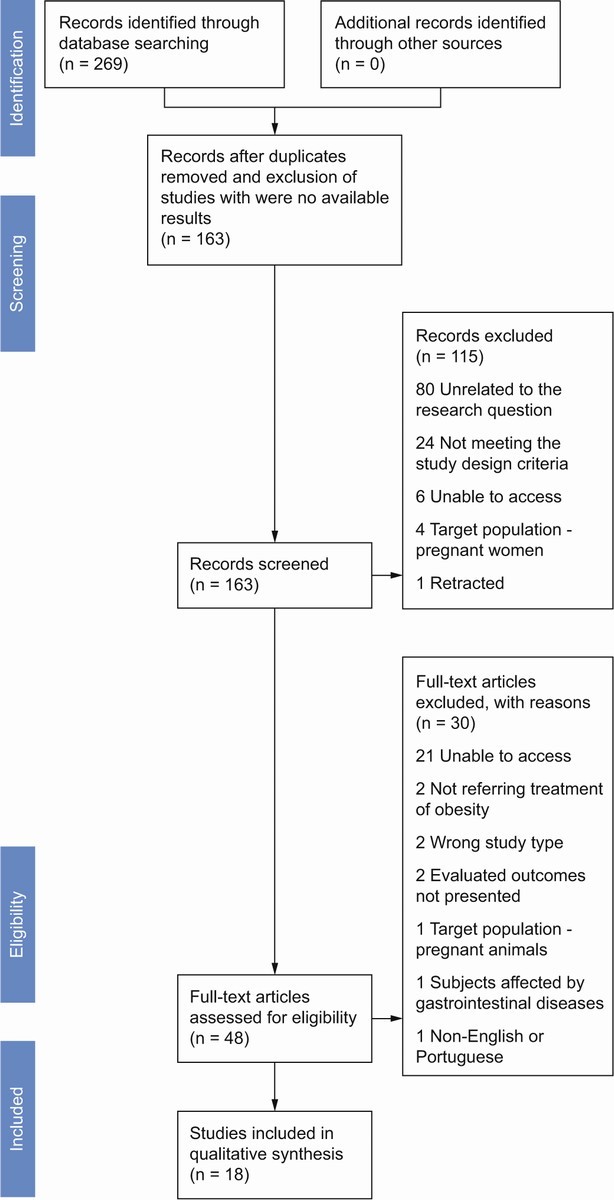
Flow diagram of the studies selection according to PRISMA guidelines.
The 16 studies searched in Clinical Trials.gov and ISRCTN were excluded from screening because there were no available results. We discarded 115 after reviewing the abstracts, in its majority for being unrelated to the research question – did not mention researching the effect of probiotics in weight neither in the title, or in the abstract (80) – or for not meeting the study type or the interventions design criteria (24). Others were excluded due to being unavailable to us,6 their target population being pregnant women4 or for being retracted.1 The assessment for eligibility yielded 48 articles. Of these, 30 did not meet the following inclusion criteria: unable to access (21), not referring treatment of obesity,2 not corresponding to the study type we intended to include – not being neither a RCT or an experimental study in experimental models,2 not mentioning the primary outcome searched in this review,2 treatment applied to pregnant animals,1 including in the sample subjects affected by gastrointestinal diseases1 or unavailable in English or Portuguese.1 A total of 4 clinical trials and 14 experimental studies were included in the systematic review.
Study characteristics and results of individual studies
In Table 2 we describe the data extracted from included human studies. We included four RCTs. All were published between 2013 and 2014. The sample size of these studies ranged from 50 to 125 (total 307). Two RCTs had the duration of 8 weeks. One study only enrolled female subjects10 and another enrolled male and female subjects but did not report data according to the gender.11
Table 2.
Data extracted from included human studies (4 RCTs).

One study had the duration of 24 weeks, reporting the results of 12 and 24 weeks of treatment12; another study had the duration of 12 weeks.13 Species of probiotics were very different between the 4 studies: 2 studies used only one strain12 (– L. rhamnosus CGMCC1.3724 and Jung 2013 – L.grasseri BNR17), the other 2 used a combination of Lactobacillus and Bifidobacterium. Among the 4 randomized clinical trials only one showed statistically significant results12 – L. rhamnosus CGMCC 1.3724 was efficient in reducing weight in females, but not in males. Validity of these was satisfactory.
Other relevant outcomes include an alteration of the profile of cytokine production by peripheral blood mononucleated cells (PBMCs) after dietary treatment with probiotics: significant decrease in Interferon gamma (IFNγ) and T-bet gene expression and significant increase in Interleucin 10 (IL10) production11; a substantially and significantly reduction of the abundance of bacteria of the Lachnospiraceae family in women at both week 12 and week 24 taking probiotics12; a reduction in Leptin serum levels of 25% after 24 weeks of intervention, independently of fat mass reduction, preferentially in women who had about 3-fold higher baseline leptin concentrations(Sanchez 2014); and also a significant difference in the change in HDL cholesterol level between the probiotics and placebo groups.10
In the Table 3 we describe the data extracted from included non-human studies.
Table 3.
Data extracted from included non-human studies (14 experimental studies).

Table 3.
(continued)
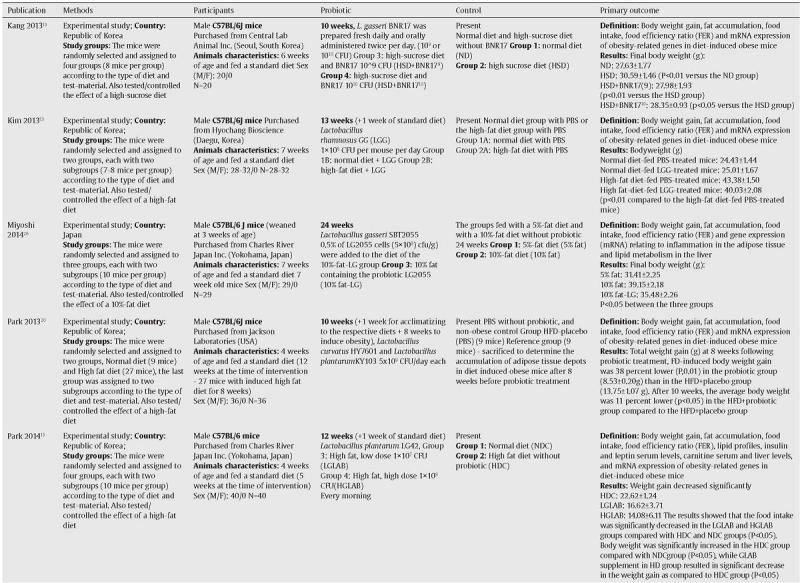
Table 3.
(continued)
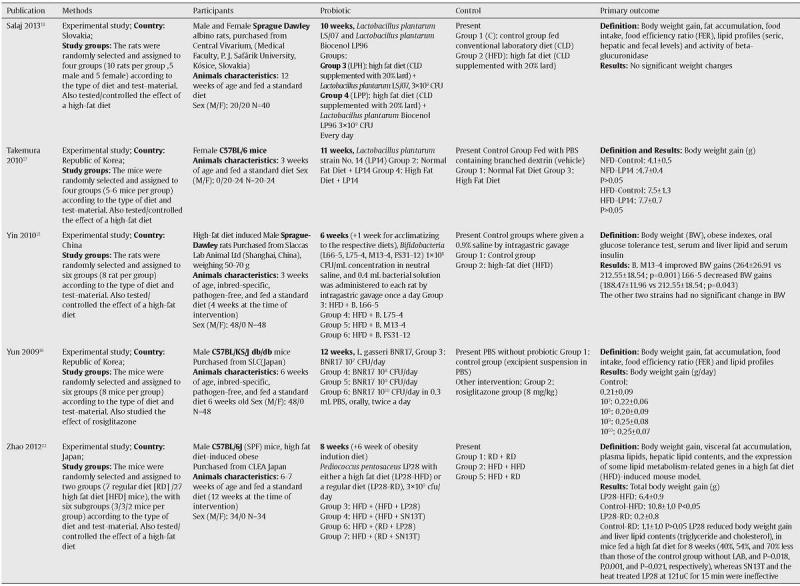
We included fourteen experimental studies. All were published between 2009 and 2014. The sample size of these studies ranged from 20 to 50 (total 481 animals). The minimum interventional duration was of 5 weeks14 and maximum interventional duration was of 24 weeks.15 Four studies used as experimental models Sprague Dawley albino rats (SDr) (total of 154 rats; 20 female/130 male), one used C57BL/KS/J db/db mice16 and the other 10 studies used C57BL/6J mice (total of 337 mice; 24 female/ 313 male). One study only enrolled female animals - C57BL/6J mice17 and another enrolled male and female animals – SDr,18 all the other studies only enrolled male animals. Four studies applied a combination of probiotics.19,20,21,22 Among these four studies, one used Bifidobacterium combination19 and another also used four Bifidobacterium strains but as mono-intervention.21 The other two used Lactobacillus combinations. One other study applied two Lactobacillus strains separately.18
Among the experimental animal trials, L. gasseri BNR17 in one study showed weight loss capability in rats, as well as reduced visceral fat accumulation.23 In another study, of the same authors,24 probiotic fed mice also showed reduced body weight. Opposing these results, other authors using the same probiotic were not supportive of these findings, showing instead a non-significant weight gain capability of this probiotic.16
Risk of bias within studies
Bias assessment for RCT included is described in the Table 4, according to the Cochrane Consumers and Communication Review Group's “risk of bias assessment tool”, judged as Low, Unclear or High risk.9
Table 4.
Bias assessment – 4 RCT.
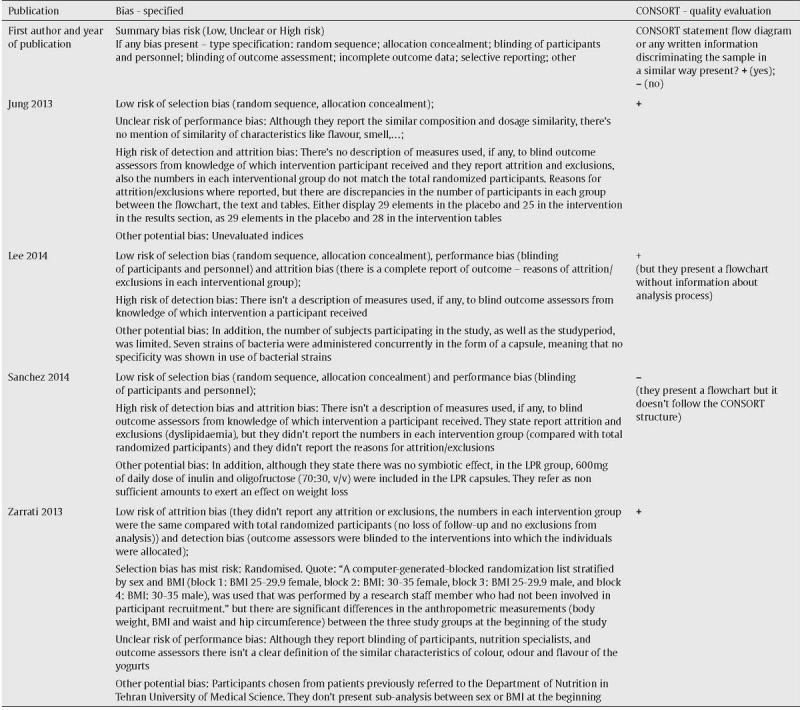
All the four included RCT as a ‘high’ risk of bias across one10 or two of the domains. Three of the four RCTs had high risk of bias in blinding of outcome (Fig. 2). The study limitations, differences in probiotics administered and participants, and small sample sizes across the included studies mean that the power to detect a trend of overall effect may be limited and chance findings cannot be excluded.
Fig. 2.
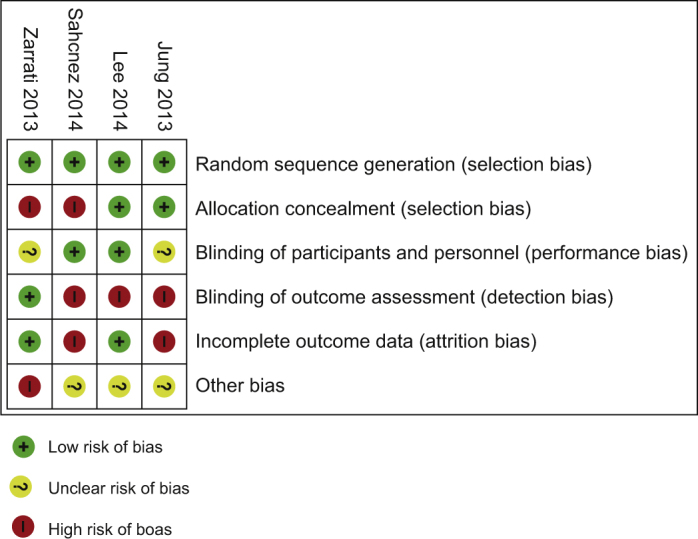
Resume of Bias analysis of the include RCT.
Synthesis of results
Primary outcome: weight change (Table 5)
Table 5.
ITT analysis of changes in weight loss: probiotics versus control.
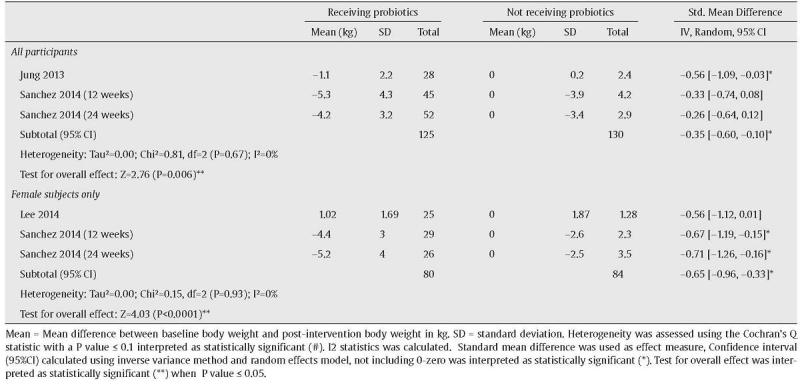
We performeda meta-analysis of weight change. This includes 3,10,12,13 of the 4 trials which reported the difference of weight (n=255) in the same measure [difference between baseline body weight and post-intervention body weight in kg]. We included data of 12 and 24 weeks analysis of Sanchez 2014 RCT. One study was only included in the subgroup analysis of female body weight changes (n=164), since it only enrolled female subjects.10 There was a significant difference (P value=0.006) between various probiotics and the control group for weight loss, with a standardized mean difference of –0.35kg in the probiotic treatment group (95% confidence interval (CI) –0.60 to –0.10) for all gender participants and in the subgroup analysis of female body weight changes (SMD –0.65; P value<0.0001; 95% CI –0.96 to –0.33).
Secondary outcome: HDL serum level (Table 6)
Table 6.
ITT analysis of changes in HDL: probiotics versus control.
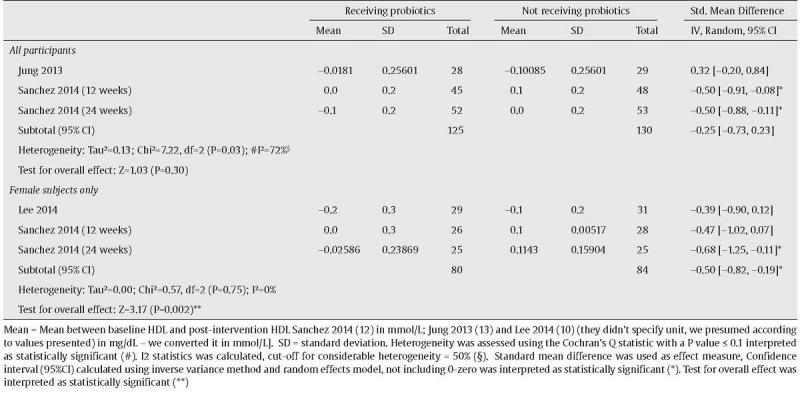
Weperformed a meta-analysis of weight change. This includes 3,10,12,13 of the 4 trials which reported the difference of HDL serum levels (n=255) in the same measure [difference between baseline HDL and post-intervention HDL Sanchez 201412 in mmol/L; Jung 201313 and Lee 201410 (they didn't specify unit, we presumed according to values presented) in mg/dL – we converted it in mmol/L]. We included data of 12 and 24 weeks analysis of Sanchez 201412 RCT. One study was only included in the subgroup analysis of female body weight changes (n=164), once it only enrolled female subjects.10 There was a significant difference (P value=0.002) between various probiotics and the control group for HDL serum levels, with a SMD of –0.50 mmol/L in the probiotic treatment group (95% CI –0.82 to –0.19) for the subgroup analysis of female participants. In the all gender participants analysis, there was no significant difference between various probiotics and the control group (SMD −0.25, 95% CI −0.73 to 0.23), with results demonstrating considerable levels of heterogeneity (Tau2=0.13; Chi2=7.22, df=2 (P value=0.03); I2=72%).
In this review, it is not sensible to perform any other meta-analysis or to present forest plots due to the very large difference in presentation of outcomes, the variability of the species and strains used, without reproduction in a consistent stratified results related to weight change and due the limited number of studies involved.
Discussion
Probiotic effect in body weight is not only species specific, but also strain specific. The 4 clinical trials and 14 experimental used different species, different combinations, had different study durations and, particularly, the experimental studies used different species participants. Outcomes were not reported in a padronized measure, not allowing to perform other meta-analysis.
Regarding other probiotic that showed promising results, L. rhamnosus GG fed mice with a high fat diet showed reduced weight when compared to high fat diet animals without this probiotic. The same did not happen when animals were fed a normal diet, having instead non-significant results.25 L. gasseri SBT2055 was effective in preventing weight gain in 10% fat diet-fed mice.26 Simultaneous feeding of animals with L. curvatus HY7601 and L. plantarum KY103 also resulted in a reduced weight gain.20 L. plantarum LG42 fed mice had a smaller weight gain than control animals, with the weight gain being smaller with higher doses of this probiotic.15 Finally, Lactobacillus L66-5 strain also showed a significant body weight decreasing power.21
Overall most attempts to use probiotics to reduce body weight, or to slow body weight gain did not have the desired results. Even though several Lactobacillus strains have been studied and some have results that support a possible beneficial weight reducing capability, with only L. rhamnosus CGMCC 1.3724 at the moment having positive results in humans.
Probiotics beneficial mechanism in host metabolism is explored Kim 2013,25 where authors propose that LGG (the probiotic strain used) sensitizes insulin action is co-mediated by an enhanced adiponectin production and AMPK activation and at least in part associated with increased expressions of GLUT4, and lipid oxidative genes in responsible tissues, such as adipose tissue, skeletal muscle and the liver and in Kang 2013,24 consistent with the hypothesis put forward in Kim 2013,25 reported that the anti-obesity effect of BNR17 is responsible for the increased expression of fatty acid metabolism-related genes rather than reduced fatty acid synthesis and fat intake in the liver.
It is relevant to mention that there is evidence that the presence of two different bacterial species modifies the mutual metabolic activity. This aspect must be taken in consideration during the establishment of the species that will integrate a probiotic. We emphasize, concerning this topic, the results of Arora 2012,14 in which the lactobacilli administration promoted an increase of colonization by Bifidobacterium, which other studies have demonstrated to be positively correlated with improved metabolic profile and normalization of inflammatory tone.
Prebiotic carbohidrates enhance the survival in the gastric (low pH) and duodenal (bile salts) conditions and proliferation of probiotics, being an useful tool to ensure the presence proliferation in the gut in the desired quantities.
Potential biases in the review process
Owing to the limited number of studies involved, it was impossible to detect publication bias. Only four RCTs met the inclusion criteria in our analysis, thus the power to detect the trend of overall effect in humans was limited and a chance finding cannot be excluded. Also, although we included 14 experimental studies, the animals species and the mode of probiotic administration and the specific strains used vary widely between studies. As the efficacy of a probiotic is highly strain-specific, the mentioned fact could account for the differences found in the outcomes of those different studies and the power to detect the trend of overall effect in experimental studies.
Limitations
Due to the variability of the species and strains used and each population specification, the majority of the included studies have low generalizability. It represented a limitation to perform a meta-analysis and to present a forest plot.
Although we included major databases, according to PRISMA statement,7 our review may not have been exhaustive because: in the PubMed central database the keywords were confined to [Title/Abstract], in the SCOPUS database were confined to TITLE- ABS-KEY, Cochrane Central Register of Controlled Trials - CENTRAL database were confined to Title, Abstract and Keyword to ensure that they were defined as key word of the articles searched; the 16 studies searched in Clinical Trials.gov and ISRCTN because these were excluded because there were no available results. In Google Scholar and ISI Web of knowledge the search did not include the outcome reference word in order to maximize the results in these databases. Our findings were also limited by the inherent limitations of the literature itself. We also consider a limitation of the search the restriction to English and Portuguese languages.
With Mesh some of our quote phrases would not be included in the real query performed by pubmed: “Weight change”[Mesh]; “BMI change”[Mesh]; “probiotic diet”[Mesh]; “probiotic therapy”[Mesh]; “probiotic supplementation”[Mesh]; “high-fat diet”[Mesh]
The correspondent Mesh terms don't have all the potential entries correspondent to the search term we used (i.e. the Mesh term Probiotics does not consider probiotic therapy as entry terms). High-fat diet has a similar Mesh term, but it was only introduced in 2012. This expression is mainly used in experimental studies, some of which have been published and indexed before 2012.
With all fields classification, we would include some quote phrases not meaningful for the study: Weight would be translated by the search engine as “weights and measures” and “body weight”. The Mesh term “body weight” does not consider weight alone as a potential entry term. With “weight”, our search also included studies that referred to “body weight” as “weight” alone.
The same rationale can be applied to other databases in addition to the fact that the query should present the minimum variability between databases.
Conclusions
In our systematic review, we found that probiotic effect in body weight is specie and strain specific. L. gasseri BNR17, reduces weight gain compared to controls; L. gasseri L66-5 promoted weight gain, L. rhamnosus GGMCC is the only one that had positive effect in weight loss in humans. In other hand, L. plantarum LG42, L. gasseri SBT2055 and L. plantarum co-therapy with KY103 and L. curvatus HY7601 had an anti-obesity effect in animal models.
The combined therapy of Lactobacillus acidophilus LA5, Lactobacillus casei DN001 and Bifidobacterium lactis Bb12 had a modulating effect in the immune system, improving the inflammatory status. L. rhamnosus CGMCC, while promoting weight gain, also reduced leptin levels, reflecting a sensitizing effect for this adipokine which may prove useful in weight gain in a less harmful form. L. gasseri BNR17 improved lipidaemia in a clinically significant way and, in an experimental study performed on Male Sprague-Dawley rats, it presented a beneficial modulation of adipose accumulation, promoting the reduction of the weight gain rate and the reduction of the accumulation of visceral adiposity.
The investigation of the usefulness of these microbes in shaping weight, and their actions as growth-promoting agents has had great developments in agriculture during the last decade.1 However, the level of clinical trials or research performed with guidance for implementing clinically isn't yet sufficient or consensual. Thus, further research is needed to assess the effect of probiotic therapy in human weight change. Finally, specific probiotics could represent important agents in the management of the two of the major and emerging epidemics worldwide: malnutrition and obesity.
Author contributions
Study concept and design: Rouxinol-Dias, AL. Acquisition of data: Pinto, AR. Analysis and interpretation of data: Rouxinol-Dias, AL, Pinto, AR, Rodrigues, D, Dias, J and Moreira, M. Drafting of the manuscript: Rouxinol-Dias, AL, Pinto, AR, Janeiro, C, Rodrigues, D, Dias, J, Moreira, M, Pereira, P. Critical revision of the manuscript for important intellectual content: Rouxinol-Dias, AL and Dias, J. Statistical analysis: Rouxinol-Dias, AL. Study supervision: Rouxinol-Dias, AL.
Competing interest statement
All authors have completed the Unified Competing Interest form at http://www.icmje.org/downloads/coi_disclosure.pdf and declare that 1 - no authors have support from probiotics companies for the submitted work; 2 - no authors have relationships with probiotics companies that might have an interest in the submitted work in the previous 3 years; 3 - their spouses, partners, or children have no financial relationships that may be relevant to the submitted work; and 4 - no authors have non-financial interests that may be relevant to the submitted work.
Acknowledgments
We would like to thank the Immunology Lab and Service for facilitating the development of this work, with special regards to our teacher, PhD. André Moreira.
References
- 1.WHO. Obesity and overweight 2014 [accessed 8 May 2014]. Fact sheet N° 311. Available from: http://www.who.int/mediacentre/factsheets/fs311/en/. [Google Scholar]
- 2.DiBaise JK, Zhang H, Crowell MD, Krajmalnik-Brown R, Decker GA, Rittmann BE. Gut microbiota and its possible relationship with obesity. Mayo Clin Proc. 2008;83:460-469. [DOI] [PubMed] [Google Scholar]
- 3.Fox CS, Massaro JM, Hoffmann U, Pou KM, Maurovich-Horvat P, Liu CY, et al. Abdominal visceral and subcutaneous adipose tissue compartments: association with metabolic risk factors in the Framingham Heart Study. Circulation. 2007;116:39-48. [DOI] [PubMed] [Google Scholar]
- 4.Tilg H, Moschen AR, Kaser A. Obesity and the microbiota. Gastroenterology. 2009;136:1476-1483. [DOI] [PubMed] [Google Scholar]
- 5.Dhurandhar NV. A framework for identification of infections that contribute to human obesity. Lancet Infect Dis. 2011;11:963-969. [DOI] [PubMed] [Google Scholar]
- 6.Raoult D. Probiotics and obesity: a link? Nat Rev Microbiol. 2009;7:616. [DOI] [PubMed] [Google Scholar]
- 7.Moher D, Liberati A, Tetzlaff J, Altman DG, Group P. Preferred reporting items for systematic reviews and meta-analyses: the PRISMA statement. BMJ. 2009;339:b2535. [DOI] [PMC free article] [PubMed] [Google Scholar]
- 8.Schulz KF, Altman DG, Moher D, Group C. CONSORT 2010 statement: updated guidelines for reporting parallel group randomised trials. PLoS Med. 2010;7:e1000251. [DOI] [PMC free article] [PubMed] [Google Scholar]
- 9.Higgins. Cochrane handbook for systematic reviews of interventions version 5.1.0 The Cochrane Collaboration; 2011. Available from: www.cochrane-handbook.org. [Google Scholar]
- 10.Lee SJ, Bose S, Seo JG, Chung WS, Lim CY, Kim H. The effects of co-administration of probiotics with herbal medicine on obesity, metabolic endotoxemia and dysbiosis: a randomized double-blind controlled clinical trial. Clin Nutr. 2014;33:973-981. [DOI] [PubMed] [Google Scholar]
- 11.Zarrati M, Shidfar F, Nourijelyani K, Mofid V, Hossein zadeh-Attar MJ, Bidad K, et al. Lactobacillus acidophilus La5, Bifidobacterium BB12, and Lactobacillus casei DN001 modulate gene expression of subset specific transcription factors and cytokines in peripheral blood mononuclear cells of obese and overweight people. Biofactors. 2013;39:633-643. [DOI] [PubMed] [Google Scholar]
- 12.Sanchez M, Darimont C, Drapeau V, Emady-Azar S, Lepage M, Rezzonico E, et al. Effect of Lactobacillus rhamnosus CGMCC1.3724 supplementation on weight loss and maintenance in obese men and women. Br J Nutr. 2014;111:1507-1519. [DOI] [PubMed] [Google Scholar]
- 13.Jung SP, Lee KM, Kang JH, Yun SI, Park HO, Moon Y, et al. Effect of Lactobacillus gasseri BNR17 on Overweight and Obese Adults: A randomized, double-blind clinical trial. Korean J Fam Med. 2013;34:80-89. [DOI] [PMC free article] [PubMed] [Google Scholar]
- 14.Arora T, Anastasovska J, Gibson G, Tuohy K, Sharma RK, Bell J, et al. Effect of Lactobacillus acidophilus NCDC 13 supplementation on the progression of obesity in diet-induced obese mice. Br J Nutr. 2012;108:1382-1389. [DOI] [PubMed] [Google Scholar]
- 15.Park JE, Oh SH, Cha YS. Lactobacillus plantarum LG42 isolated from gajami sik-hae decreases body and fat pad weights in diet-induced obese mice. J Appl Microbiol. 2014;116:145-156. [DOI] [PubMed] [Google Scholar]
- 16.Yun SI, Park HO, Kang JH. Effect of Lactobacillus gasseri BNR17 on blood glucose levels and body weight in a mouse model of type 2 diabetes. J Appl Microbiol. 2009;107:1681-1686. [DOI] [PubMed] [Google Scholar]
- 17.Takemura N, Okubo T, Sonoyama K. Lactobacillus plantarum strain No. 14 reduces adipocyte size in mice fed high-fat diet. Exp Biol Med (Maywood). 2010;235:849-856. [DOI] [PubMed] [Google Scholar]
- 18.Salaj R, Stofilova J, Soltesova A, Hertelyova Z, Hijova E, Bertkova I, et al. The effects of two Lactobacillus plantarum strains on rat lipid metabolism receiving a high fat diet. ScientificWorldJournal. 2013;2013:135142. [DOI] [PMC free article] [PubMed] [Google Scholar]
- 19.An HM, Park SY, Lee do K, Kim JR, Cha MK, Lee SW, et al. Antiobesity and lipid-lowering effects of Bifidobacterium spp. in high fat diet-induced obese rats. Lipids Health Dis. 2011;10:116. [DOI] [PMC free article] [PubMed] [Google Scholar]
- 20.Park DY, Ahn YT, Park SH, Huh CS, Yoo SR, Yu R, et al. Supplementation of Lactobacillus curvatus HY7601 and Lactobacillus plantarum KY1032 in diet-induced obese mice is associated with gut microbial changes and reduction in obesity. PLoS One. 2013;8:e59470. [DOI] [PMC free article] [PubMed] [Google Scholar]
- 21.Yin YN, Yu QF, Fu N, Liu XW, Lu FG. Effects of four Bifidobacteria on obesity in high-fat diet induced rats. World J Gastroenterol. 2010;16:3394-3401. [DOI] [PMC free article] [PubMed] [Google Scholar]
- 22.Zhao X, Higashikawa F, Noda M, Kawamura Y, Matoba Y, Kumagai T, et al. The obesity and fatty liver are reduced by plant-derived Pediococcus pentosaceus LP28 in high fat diet-induced obese mice. PLoS One. 2012;7:e30696. [DOI] [PMC free article] [PubMed] [Google Scholar]
- 23.Kang JH, Yun SI, Park HO. Effects of Lactobacillus gasseri BNR17 on body weight and adipose tissue mass in diet-induced overweight rats. J Microbiol. 2010;48:712-714. [DOI] [PubMed] [Google Scholar]
- 24.Kang JH, Yun SI, Park MH, Park JH, Jeong SY, Park HO. Anti-obesity effect of Lactobacillus gasseri BNR17 in high-sucrose diet-induced obese mice. PLoS One. 2013;8:e54617. [DOI] [PMC free article] [PubMed] [Google Scholar]
- 25.Kim SW, Park KY, Kim B, Kim E, Hyun CK. Lactobacillus rhamnosus GG improves insulin sensitivity and reduces adiposity in high-fat diet-fed mice through enhancement of adiponectin production. Biochem Biophys Res Commun. 2013;431:258-263. [DOI] [PubMed] [Google Scholar]
- 26.Miyoshi M, Ogawa A, Higurashi S, Kadooka Y. Anti-obesity effect of Lactobacillus gasseri SBT2055 accompanied by inhibition of pro-inflammatory gene expression in the visceral adipose tissue in diet-induced obese mice. Eur J Nutr. 2014;53:599-606. [DOI] [PubMed] [Google Scholar]
- 27.Clarke SF, Murphy EF, O'Sullivan O, Ross RP, O'Toole PW, Shanahan F, et al. Targeting the microbiota to address diet-induced obesity: a time dependent challenge. PLoS One. 2013;8:e65790. [DOI] [PMC free article] [PubMed] [Google Scholar]


